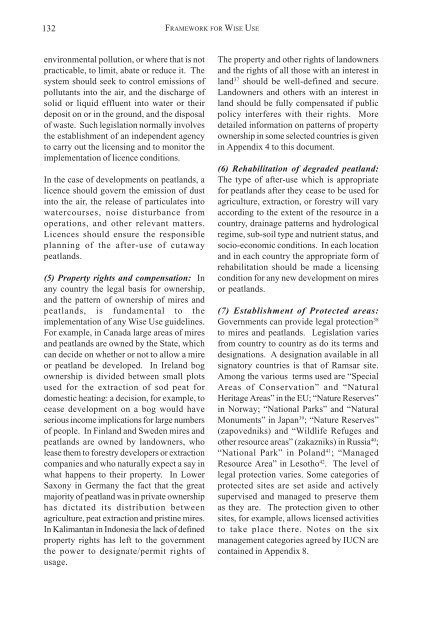wise use of mires and peatlands - Peatland Ecology Research Group
wise use of mires and peatlands - Peatland Ecology Research Group
wise use of mires and peatlands - Peatland Ecology Research Group
You also want an ePaper? Increase the reach of your titles
YUMPU automatically turns print PDFs into web optimized ePapers that Google loves.
132 FRAMEWORK FOR WISE USEenvironmental pollution, or where that is notpracticable, to limit, abate or reduce it. Thesystem should seek to control emissions <strong>of</strong>pollutants into the air, <strong>and</strong> the discharge <strong>of</strong>solid or liquid effluent into water or theirdeposit on or in the ground, <strong>and</strong> the disposal<strong>of</strong> waste. Such legislation normally involvesthe establishment <strong>of</strong> an independent agencyto carry out the licensing <strong>and</strong> to monitor theimplementation <strong>of</strong> licence conditions.In the case <strong>of</strong> developments on peatl<strong>and</strong>s, alicence should govern the emission <strong>of</strong> dustinto the air, the release <strong>of</strong> particulates intowatercourses, noise disturbance fromoperations, <strong>and</strong> other relevant matters.Licences should ensure the responsibleplanning <strong>of</strong> the after-<strong>use</strong> <strong>of</strong> cutawaypeatl<strong>and</strong>s.(5) Property rights <strong>and</strong> compensation: Inany country the legal basis for ownership,<strong>and</strong> the pattern <strong>of</strong> ownership <strong>of</strong> <strong>mires</strong> <strong>and</strong>peatl<strong>and</strong>s, is fundamental to theimplementation <strong>of</strong> any Wise Use guidelines.For example, in Canada large areas <strong>of</strong> <strong>mires</strong><strong>and</strong> peatl<strong>and</strong>s are owned by the State, whichcan decide on whether or not to allow a mireor peatl<strong>and</strong> be developed. In Irel<strong>and</strong> bogownership is divided between small plots<strong>use</strong>d for the extraction <strong>of</strong> sod peat fordomestic heating: a decision, for example, tocease development on a bog would haveserious income implications for large numbers<strong>of</strong> people. In Finl<strong>and</strong> <strong>and</strong> Sweden <strong>mires</strong> <strong>and</strong>peatl<strong>and</strong>s are owned by l<strong>and</strong>owners, wholease them to forestry developers or extractioncompanies <strong>and</strong> who naturally expect a say inwhat happens to their property. In LowerSaxony in Germany the fact that the greatmajority <strong>of</strong> peatl<strong>and</strong> was in private ownershiphas dictated its distribution betweenagriculture, peat extraction <strong>and</strong> pristine <strong>mires</strong>.In Kalimantan in Indonesia the lack <strong>of</strong> definedproperty rights has left to the governmentthe power to designate/permit rights <strong>of</strong>usage.The property <strong>and</strong> other rights <strong>of</strong> l<strong>and</strong>owners<strong>and</strong> the rights <strong>of</strong> all those with an interest inl<strong>and</strong> 37 should be well-defined <strong>and</strong> secure.L<strong>and</strong>owners <strong>and</strong> others with an interest inl<strong>and</strong> should be fully compensated if publicpolicy interferes with their rights. Moredetailed information on patterns <strong>of</strong> propertyownership in some selected countries is givenin Appendix 4 to this document.(6) Rehabilitation <strong>of</strong> degraded peatl<strong>and</strong>:The type <strong>of</strong> after-<strong>use</strong> which is appropriatefor peatl<strong>and</strong>s after they cease to be <strong>use</strong>d foragriculture, extraction, or forestry will varyaccording to the extent <strong>of</strong> the resource in acountry, drainage patterns <strong>and</strong> hydrologicalregime, sub-soil type <strong>and</strong> nutrient status, <strong>and</strong>socio-economic conditions. In each location<strong>and</strong> in each country the appropriate form <strong>of</strong>rehabilitation should be made a licensingcondition for any new development on <strong>mires</strong>or peatl<strong>and</strong>s.(7) Establishment <strong>of</strong> Protected areas:Governments can provide legal protection 38to <strong>mires</strong> <strong>and</strong> peatl<strong>and</strong>s. Legislation variesfrom country to country as do its terms <strong>and</strong>designations. A designation available in allsignatory countries is that <strong>of</strong> Ramsar site.Among the various terms <strong>use</strong>d are “SpecialAreas <strong>of</strong> Conservation” <strong>and</strong> “NaturalHeritage Areas” in the EU; “Nature Reserves”in Norway; “National Parks” <strong>and</strong> “NaturalMonuments” in Japan 39 ; “Nature Reserves”(zapovedniks) <strong>and</strong> “Wildlife Refuges <strong>and</strong>other resource areas” (zakazniks) in Russia 40 ;“National Park” in Pol<strong>and</strong> 41 ; “ManagedResource Area” in Lesotho 42 . The level <strong>of</strong>legal protection varies. Some categories <strong>of</strong>protected sites are set aside <strong>and</strong> activelysupervised <strong>and</strong> managed to preserve themas they are. The protection given to othersites, for example, allows licensed activitiesto take place there. Notes on the sixmanagement categories agreed by IUCN arecontained in Appendix 8.
















